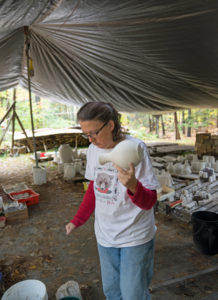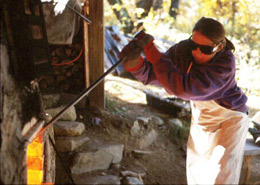Firing the Kiln

Each May and October I fire the anagama kiln. I chose those months because May is when the weather first gets warm enough and October is before it gets too cold again. The kiln holds about 800 pots, from large to small, made over a period of three to four months.
The loading of the kiln is perhaps the most difficult part of the process, requiring concentration over four long days. The location of each pot must be carefully considered as its placement in the kiln, whether in the top, bottom, front or back, whether it holds another pot on shells or wadding within it, or whether it is on its side or on its foot will determine the final look of the pot.
The path of the flame, and the way it will interact with the pots is determined by the loading. Unglazed flatware will usually be loaded with rice straw on it, which will leave striking red marks where it interacts with the clay body and softer yellow marks where it catches and fluxes the ash.

The kiln is stoked with wood twenty-four hours a day by a crew of four for eight days. Each firing takes five to six cords of hard wood. I use what I call the “Maine mix,” which is a mixture of oak, maple, ash, beech and a little birch. The kiln is side stoked with long skinny pieces of oak, which are a by-product of the lobster trap industry.
Wood ash is carried through the kiln on the flame, blanketing the pots and melting at top temperature to create the beautiful ashy surfaces.
After the front of the kiln has been at peak temperature for one to two days, wood is introduced into the sides of the kiln to bring the back up to temperature. The firing is done when we reach a temperature of 2350 degrees throughout the kiln. Test rings are pulled to ensure that surfaces are ashy and that the ash is melted.
The kiln cools for one week, and the unloading day is always a highly anticipated event. My expectations and predictions are sometimes fulfilled, but sometimes wildly surpassed. Each pot is unique, telling its own story of where and how it was fired.

My firing crew has been a slowly rotating group of great potters who bring their pots, energy, and enthusiasm for the firing. Twice a year we spend thirteen days together, loading and firing the kiln, making meals (click for recipes), stacking wood, trading stories and talking about pots. They have become close friends of the family and the period when they are here is one my favorite times of the year. Current members include David Orser, Simon van der Ven, Meghan Flynn, Cory Upton-Coselich, Betsy Levine, Andrea Dove and Jean Hardy.
